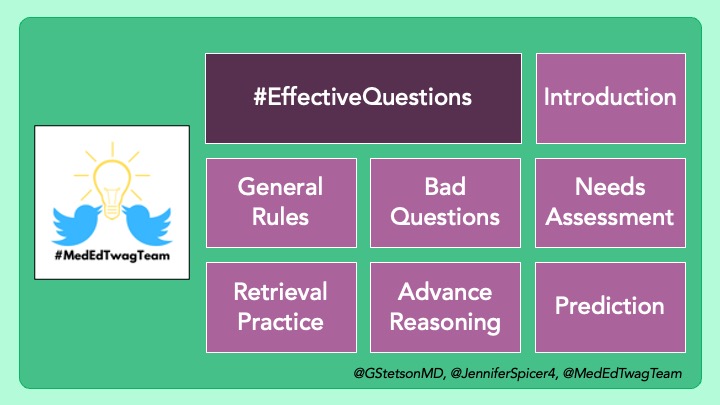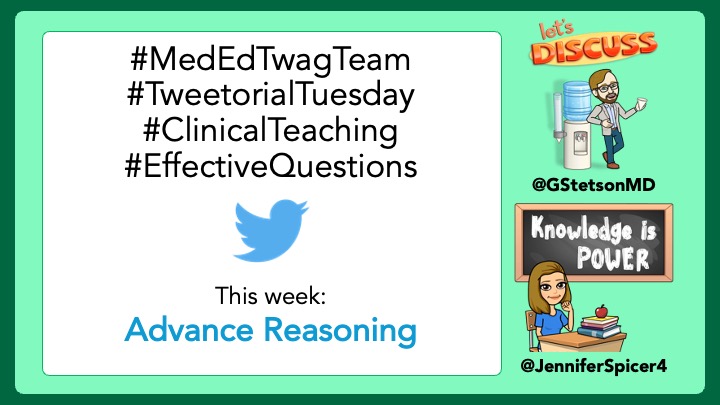
1/ Welcome back to #TweetorialTuesday with the #MedEdTwagTeam!
We are in our #EffectiveQuestions series.
Thanks for joining us, #MedTwitter, #MedEd, #Tweetatrician, & #MedStudentTwitter Friends!
We are in our #EffectiveQuestions series.
Thanks for joining us, #MedTwitter, #MedEd, #Tweetatrician, & #MedStudentTwitter Friends!

2/ This is our last specific topic in the #EffectiveQuestions series, and it is a favorite!
Today is about how to leverage the power of prediction to engage your trainees and enhance their learning.
Today is about how to leverage the power of prediction to engage your trainees and enhance their learning.

3/ Today’s thread is based on Chapter 2 from #SmallTeaching.
I love this book by @LangOnCourse. It is right up there with #MakeItStick and #HowLearningWorks, IMHO.
Really digestible, and the information can be applied to your practice the following day.
I love this book by @LangOnCourse. It is right up there with #MakeItStick and #HowLearningWorks, IMHO.
Really digestible, and the information can be applied to your practice the following day.

4/ Much of what @LangOnCourse describes is how to apply the science of learning to the classroom setting. However, it applies just as easily to the clinical setting.
My favorite idea from this book is: making a prediction about how something may evolve or result.
My favorite idea from this book is: making a prediction about how something may evolve or result.
5/ We do this all the time when we ask learners to “put their nickel down.”
We are asking them to commit to a potential diagnosis, or plan of action, before they get feedback from either their patient, their supervisor, laboratory/imaging results, clinical data, etc.
We are asking them to commit to a potential diagnosis, or plan of action, before they get feedback from either their patient, their supervisor, laboratory/imaging results, clinical data, etc.
6/ Generating a prediction does a few things to improve learning from an emotional & cognitive standpoint: 

8/ Below are some examples of prediction questions. As you can see, a prediction can be made about a lot of things we do in clinical care. What other predictions do you like to make with your learners? 

9/ After a prediction, & you find out if you were right or wrong, it is vitally important to reflect on the outcome of the prediction.
Were you right? Was it because you reasoned correctly?
If you were wrong, what about your current understanding led to an incorrect guess?
Were you right? Was it because you reasoned correctly?
If you were wrong, what about your current understanding led to an incorrect guess?

10/ The reflection/feedback should come as close to the prediction as possible. Wrong predictions are very effective at facilitating learning, as long as they are not allowed to hang around by going uncorrected.
11/ I hope you enjoyed this thread as much as I enjoy using this technique.
I find prediction to be a fun, low-stakes way to stimulate learners’ curiosity, and get them prepared to understand their patients’ clinical problems more deeply.
I find prediction to be a fun, low-stakes way to stimulate learners’ curiosity, and get them prepared to understand their patients’ clinical problems more deeply.

12/ This is the last topic week in the #EffectiveQuestions series. Next week will be a summary of what we have covered.
The week after that, my #MedEdBFF @JenniferSpicer4 will introduce our next theme.
Make sure you are following me, Jen, & the @MedEdTwagTeam.
Tweet you then!
The week after that, my #MedEdBFF @JenniferSpicer4 will introduce our next theme.
Make sure you are following me, Jen, & the @MedEdTwagTeam.
Tweet you then!

• • •
Missing some Tweet in this thread? You can try to
force a refresh






















